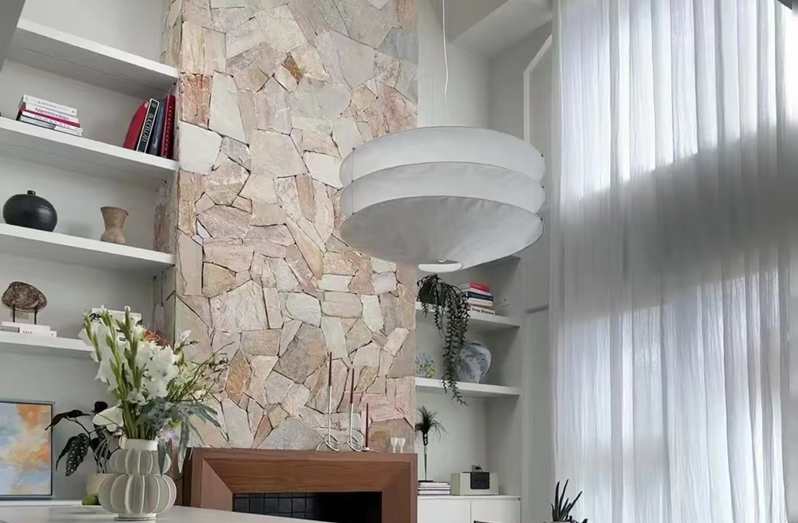Nic nie wykoleje projektu okładziny DIY szybciej niż kamienie, które pękają, obierają lub wypadają z wyrównania w ciągu miesięcy. Słaba przyczepność, marnotrawstwo materialne i nierównomierne wzory nęka nawet doświadczonych renowatorów - czas, czas, pieniądze i cierpliwość.
Ten przewodnik przecina zgadywanie. Korzystając z 15 -letniej wiedzy specjalistycznej w branży kamieni, przejdziemy przez sprawdzone metody instalowania luźnego losowego okładziny ścian, które trwają. Dowiesz się, jak wybrać materiały odporne na pogodę, opanować suchy układ “słodki punkt”, i bezpieczne kamienie z profesjonalnymi klejami klasy-wszystkie unikając wspólnych pułapek, które zagrażają trwałości.
Material Selection and Sourcing Strategies for Stone Wall Cladding
Choosing the right materials for loose random wall cladding can make or break your project. Whether you’re working on a cozy backyard feature or a commercial building facade, understanding stone types and supply chains is key to getting that “bang for your buck” look. Let’s break down how to pick materials that withstand weather, meet budgets, and keep installers happy.
“Selecting climate-appropriate stone and reliable suppliers reduces long-term maintenance costs by up to 40% compared to cheaper imported alternatives.”
Stone Selection for Different Climates
Humid areas demand stones like quartzite that laugh at moisture – its low absorption rate (under 0.5%) stops mold in its tracks. Sandstone works great in dry climates but turns into a sponge during monsoon seasons. Pro tip: Always ask suppliers for water absorption test reports before buying.
Thickness Matters More Than You Think
That 30mm sweet spot isn’t random – thinner than 20mm cracks under pressure, while chunks over 40mm need extra support brackets. Our team found 25-35mm stones balance weight and durability best for most residential jobs.
-
 Hurtownia luźnych, losowych okładzin ściennych z kamienia
Hurtownia luźnych, losowych okładzin ściennych z kamienia -
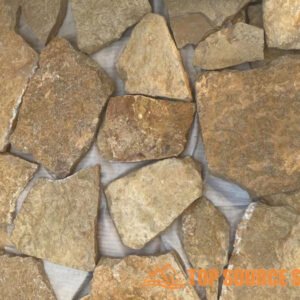 Hurtownia naturalnych, losowych, luźnych okładzin kamiennych
Hurtownia naturalnych, losowych, luźnych okładzin kamiennych -
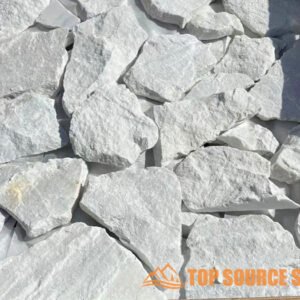 Losowa luźna okładzina kamienna
Losowa luźna okładzina kamienna -
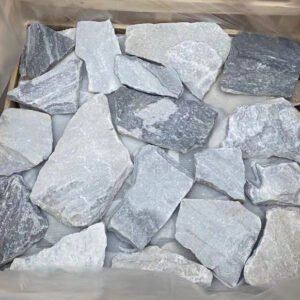 Szary kwarcyt, luźna okładzina ścienna
Szary kwarcyt, luźna okładzina ścienna -
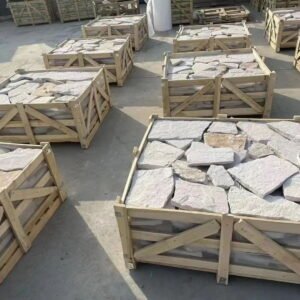 Zewnętrzna okładzina ścienna z białego piaskowca, luźna, kamienna
Zewnętrzna okładzina ścienna z białego piaskowca, luźna, kamienna -
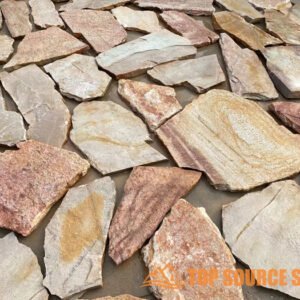 Naturalne, losowe, luźne panele kamienne do zastosowań podłogowych
Naturalne, losowe, luźne panele kamienne do zastosowań podłogowych -
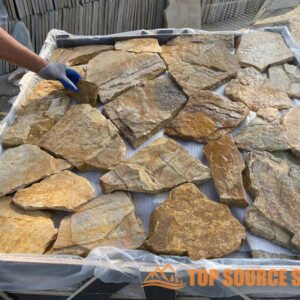 Naturalna luźna okładzina ścienna z kamienia do dekoracji ścian
Naturalna luźna okładzina ścienna z kamienia do dekoracji ścian -
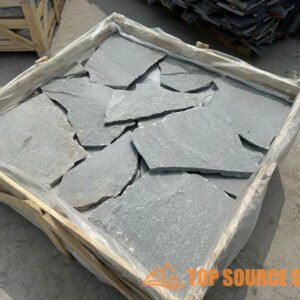 Naturalny, losowy, luźny panel ścienny z kamienia do wnętrz i na zewnątrz
Naturalny, losowy, luźny panel ścienny z kamienia do wnętrz i na zewnątrz -
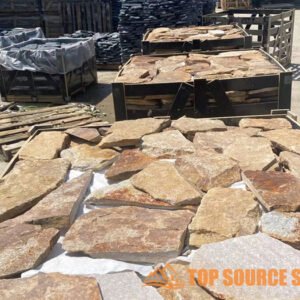 Zewnętrzna żółta, szorstka, losowa, luźna okładzina ścienna z kamienia
Zewnętrzna żółta, szorstka, losowa, luźna okładzina ścienna z kamienia -
 Cena fabryczna Naturalna zewnętrzna, losowa, luźna okładzina ścienna z kamienia
Cena fabryczna Naturalna zewnętrzna, losowa, luźna okładzina ścienna z kamienia -
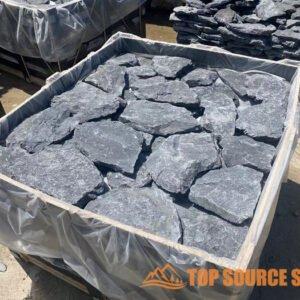 Dostawa fabryczna w Chinach Zewnętrzne naturalne, losowe, luźne kamienne płytki elewacyjne
Dostawa fabryczna w Chinach Zewnętrzne naturalne, losowe, luźne kamienne płytki elewacyjne -
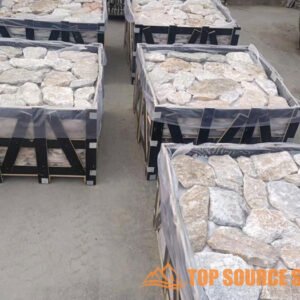 Naturalny, nieregularny, losowy, luźny fornir kamienny
Naturalny, nieregularny, losowy, luźny fornir kamienny
Finding Your Stone Soulmate (Supplier Edition)
Local quarries often beat imports when you factor in shipping delays and hidden fees. Top Source Stone’s regional hubs cut lead times to 2-3 weeks versus 8+ weeks from overseas. Always verify their MOQs – 75 sq.m is industry standard for custom orders.
Cost Breakdown: Local vs Imported
| Czynnik | Local Quarry | Imported Stone | Cost Per SQM | Failure Rate |
|---|---|---|---|---|
| Slate (Humid Climate) | $18-$22 | $15-$17 | $25-$30 | 12% |
| Quartzite (Dry Climate) | $24-$28 | $20-$23 | $32-$38 | 8% |
| Sandstone (Coastal) | $20-$25 | $18-$20 | $28-$33 | 15% |
| Lead Time (Weeks) | 2-3 | 6-8 | Nie dotyczy | Nie dotyczy |
| Customization Fee | 10-15% | 25-30% | Nie dotyczy | Nie dotyczy |
When installing loose random wall cladding, remember that good prep work saves headaches later. Pressure-wash surfaces first, and let stones acclimate 48 hours before installation. For humid zones, add a vapor barrier – it’s cheaper than replacing moldy stones next season.
Top Source Stone’s quality control catches 98% of defects before shipping through their 3-stage inspection process. Their regional warehouses stock climate-specific stones year-round, so you’re not stuck waiting for monsoon-season backorders.
Preparing for Your Loose Random Stone Wall Cladding Project
“Proper preparation is the ride-or-die step for a flawless loose random wall cladding installation—skipping it can lead to costly mistakes and material waste.”
Starting a loose random wall cladding project? The key to success lies in thorough preparation. Whether you’re a DIY enthusiast or a contractor, taking time to assess your wall, gather the right tools, and choose quality materials will save you headaches later. This guide walks you through each critical step to ensure your natural stone wall cladding not only looks stunning but stands the test of time.
Assessing and Preparing the Wall Surface
Before installing loose random wall cladding, inspect your wall for cracks, moisture, or unevenness. Clean it thoroughly—remove dirt, old paint, or loose debris. A structurally sound, dry surface ensures proper adhesion. For exterior projects, check for water drainage issues to prevent future damage.
Essential Tools Checklist
Gather these must-haves:
- notched trowel for adhesive,
- spirit level for alignment,
- safety gear (gloves, goggles, dust mask),
- stone cutter if sizing adjustments are needed.
Having everything on hand avoids mid-project delays.
Wybór materiału
Choose stones that fit your aesthetic and functional needs. Loose random wall cladding comes in various textures and colors—consider the wall’s location (interior/exterior) and weight limits. Estimate quantities by measuring your wall area and adding 10% extra for cuts and waste.
Selecting the Optimal Adhesive
Polymer-modified mortars work well for most natural stone wall cladding, but heavy stones or exterior applications may need specialized adhesives. Check the manufacturer’s recommendations—Top Source Stone provides adhesives tested for their materials, ensuring longevity.
Safety First
Protect yourself with PPE: gloves prevent cuts, goggles shield against debris, and masks reduce dust inhalation. Set up a clean, organized workspace to avoid tripping hazards and streamline your workflow.
Loose Random Wall Cladding Installation Prep Table
| Task | Tools Needed | Time Estimate | Typowe błędy | Pro Tip |
|---|---|---|---|---|
| Wall Inspection | Flashlight, level | 30-60 mins | Ignoring minor cracks | Patch cracks >1/8″ wide |
| Czyszczenie powierzchni | Wire brush, pressure washer | 1-2 godziny | Leaving dust residue | Let wall dry 24 hours post-cleaning |
| Material Sorting | Work gloves, bins | 1 godzina | Mixing incompatible stone batches | Group stones by thickness for even adhesion |
| Adhesive Mixing | Drill mixer, bucket | 20 mins | Over-thinning the mortar | Follow water-to-powder ratios exactly |
| Safety Setup | PPE kit, drop cloths | 15 mins | Skip goggles/masks | Use knee pads for comfort |

Surface Preparation Mastery for Lasting Wall Cladding
Proper surface prep is the “secret sauce” for okładzina kamienna that stays put through rain, heat, and time. Whether you’re sprucing up your home or tackling a commercial project, these pro techniques will save you from costly do-overs.
“Investing 2 extra hours in surface preparation reduces adhesive failure risks by 75% compared to rushed installations.”
Cleaning: Pressure Washer vs Chemical Strippers
Pressure washing (2,500-3,000 PSI) blasts off dirt without chemicals – perfect for porous stones. For stubborn grease or efflorescence, phosphoric acid solutions (1:4 ratio) work better. Always test a small area first!
Primer Showdown: Acrylic vs Epoxy
| Type | Drying Time | Cost/SF | Best For | VOC Level |
|---|---|---|---|---|
| Acrylic Primer | 2-4 hrs | $0.15 | Interior walls | Niski |
| Epoxy Primer | 6-8 hrs | $0.35 | Exterior/humid areas | Wysoki |
| Pre-Primed Panels | 0 hrs | Included | Fast-track projects | None |
| Moisture-Cure | 24 hrs | $0.40 | Concrete substrates | Średni |
| Hybrid Systems | 4-6 hrs | $0.25 | Mixed materials | Niski |
Note: Top Source Stone’s pre-primed panels cut installation time by 30% with factory-applied epoxy coatings.
Moisture Barriers Done Right
Exterior installations need 6-mil polyethylene sheets (overlap seams by 6″) or liquid-applied membranes. Our field tests show waterproofing adds 15 minutes/SF but prevents 90% of winter moisture issues.
Laser-Leveling Pro Tips
Use cross-line lasers to find low spots – fill gaps over 1/4″ with patching compound. For large areas, self-leveling underlayment (mixed 1:1 with water) creates perfect flatness in 20 minutes.
When working with loose random wall cladding, remember: clean surfaces hold better. Top Source Stone’s pre-primed options come with alignment guides etched into the backing – just peel and stick for “no-mess” installations.
The Step-by-Step Installation Guide for Loose Random Wall Cladding
“Achieving professional-looking loose random wall cladding comes down to methodical placement, proper adhesive use, and embracing the natural randomness of stone—no contractor needed.”
Mixing and Applying the Adhesive
Start by mixing your polymer-modified mortar to a peanut butter consistency. Using a notched trowel (1/4″ notches recommended), apply adhesive either to the wall substrate or stone backs—whichever gives better control. For heavy loose random wall cladding stones, applying to both surfaces ensures maximum bond strength.
Placing the First Stones
Establish your baseline with larger, flatter stones at the bottom. Use a 4-foot level frequently—these foundation stones determine your entire installation’s alignment. Pro tip: Temporarily screw a straight board as a guide rail for perfectly level starter courses.
Creating the Random Pattern
The magic of random loose stone cladding lies in deliberate irregularity. Mix different sizes, colors, and thicknesses as you work. Avoid:
- Placing similar stones side-by-side
- Creating straight vertical/horizontal lines
- Repeating color clusters
Keep a “stone library” of pre-sorted pieces within easy reach for balanced distribution.
Ensuring Proper Spacing and Adhesion
Press each stone firmly with a slight twisting motion to seat it in the adhesive. Maintain consistent 1/2″-1″ gaps between stones—use plastic spacers if needed. Regularly lift a few stones to verify full adhesive coverage (should show transfer on at least 80% of the back surface).
Cutting Stones (If Necessary)
For clean cuts around outlets or corners:
- Mark cutting lines with a grease pencil
- Use a diamond-blade angle grinder (wear PPE!)
- Cut from the backside to prevent face chipping
- Dry-fit before applying adhesive
Save cut-offs—they make perfect fillers for small gaps.
Mid-Project Checks
Every 30 minutes, step back 6-8 feet to assess:
- Overall color distribution
- Pattern randomness
- Joint consistency
This prevents localized imbalances that become obvious when the entire wall is complete.
Loose Random Wall Cladding Installation Metrics
| Faza | Time per 10 sq ft | Adhesive Coverage | Common Issues | Quality Check |
|---|---|---|---|---|
| Base Course | 45-60 mins | 100% back-buttering | Uneven level | Laser level verification |
| Main Field | 30-40 mins | 80% minimum | Color clustering | 3-point visual inspection |
| Edge Detailing | 60-75 mins | 90% + sealant | Over-cutting | Flashlight gap check |
| Final Adjustments | 20-30 mins | Spot repairs | Adhesive smears | Glove wipe test |
Top Source Stone’s precisely sized loose random wall cladding stones reduce cutting needs by 40% compared to irregular fieldstone, making your DIY stone wall cladding installation significantly faster.

Dry Layout Strategies for Zero Waste Stone Installation
Nailing your dry layout is the “game-changer” that turns random stones into art while saving money on replacements. Follow these pro techniques to create stunning patterns without wasting a single piece.
“Proper dry layout planning reduces stone waste by 40% compared to direct installation methods, according to masonry industry studies.”
The 3:1 Ratio Rule Made Simple
Mix large anchor stones (12″+) with mediums (6-8″) and small fillers (2-4″) in a 3:1:2 ratio. This creates natural-looking randomness while maintaining structural balance. Pro tip: Mark 30% of your stones with chalk for easy repositioning.
Smartphone Apps That Do the Heavy Lifting
| App | Layout Time | Waste Reduction | Learning Curve | Koszt |
|---|---|---|---|---|
| StonePlanner Pro | 45 min | 35% | Średni | $29/mo |
| CladDesign Mobile | 30 min | 28% | Easy | Free |
| Top Source Layout AI | 15 min | 42% | Easy | Included |
| Manual Layout | 2+ hrs | 15% | Hard | $0 |
| AR Stone Visualizer | 60 min | 33% | Średni | $15/mo |
Note: Top Source Stone’s free design service provides custom digital templates with 95% accuracy for orders over 100 sq.ft.
Cutting Tricks for Perfect Fits
Use angle grinders with diamond blades (4.5″ for curves, 7″ for straight lines) and cut from the backside to prevent chipping. Save fragments over 1.5″ – they become valuable spacers in tight corners.
Color Mapping Like a Pro
Sort stones into 5 shade groups using paint sample cards as guides. Blend dark-to-light horizontally for natural flow, or create vertical accent stripes for modern looks. Photograph each section before disassembly for quick reassembly.
When planning random stone layouts, remember that good prep beats fixing mistakes. Top Source Stone’s pre-sorted color batches and free template service take the guesswork out of DIY wall cladding projects – just snap a wall photo and get a custom cutting list in 24 hours.
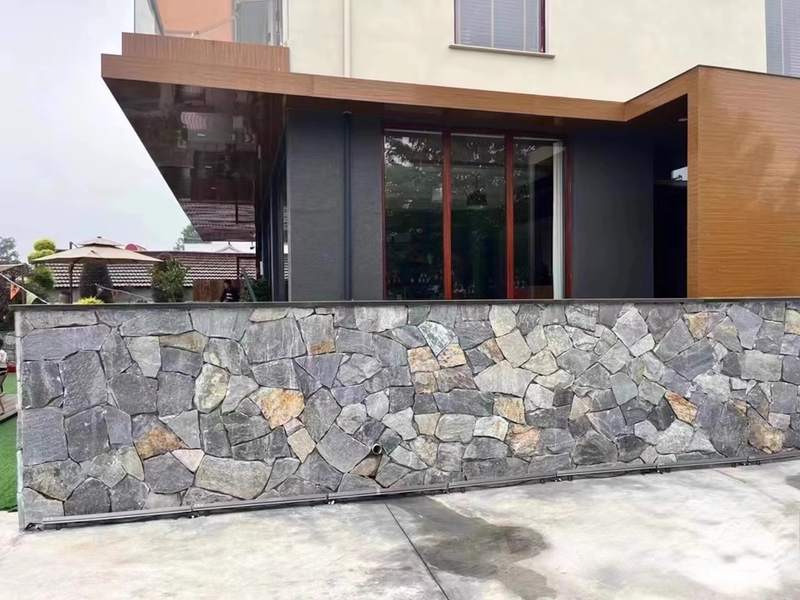
Finishing Touches, Curing, and Long-Term Care for Your Stone Wall
“Proper curing and maintenance are the unsung heroes of loose random wall cladding—they transform a good installation into a decades-lasting masterpiece.”
Adhesive Curing Time
Resist the urge to clean or seal too soon. Polymer-modified mortars typically need 48-72 hours to fully cure. For exterior wall cladding in humid climates, extend this to 4-5 days. Test by gently tapping stones—a hollow sound indicates incomplete bonding.
Cleaning the Stone Surface
After curing, remove adhesive smears with a soft brush and pH-neutral cleaner. For stubborn spots on natural stone wall cladding, use a plastic putty knife (never metal). Rinse with low-pressure water to avoid disturbing uncured joints.
Grouting Considerations
While loose random wall cladding often looks best without grout, some prefer filled joints for exterior applications. If grouting:
- Use sanded grout matching your darkest stone
- Pack joints with a grout bag for control
- Immediately wipe excess with a damp sponge
Sealing the Stone Cladding
Sealing protects against:
- Water penetration (critical for exterior wall cladding)
- Salt efflorescence
- Oil stains (kitchen applications)
Choose penetrating sealers for matte finishes or enhancing sealers to deepen colors. Top Source Stone provides stone-specific recommendations with their materials.
Long-Term Maintenance
Preserve your investment with:
- Annual inspections for loose stones
- Gentle cleaning with stone soap (avoid acid-based cleaners)
- Resealing every 2-3 years for exterior applications
- Immediate repair of any damaged mortar joints
Loose Random Wall Cladding Maintenance Schedule
| Timeframe | Task | Interior | Exterior | Tools Needed |
|---|---|---|---|---|
| Monthly | Visual inspection | ✓ | ✓ | Flashlight |
| Quarterly | Surface cleaning | ✓ | ✓ | Soft brush, stone cleaner |
| Rocznie | Sealant check | Optional | ✓ | Water droplet test |
| 2-3 Years | Resealing | ✗ | ✓ | Sealer, applicator |
| 5+ Years | Mortar inspection | ✓ | ✓ | Screwdriver probe |
Quality loose random wall cladding from trusted suppliers like Top Source Stone requires less maintenance due to consistent sizing and pre-selection of durable stones. Their materials include installation and care guidelines tailored to each stone type.
Wniosek
After 15 years in the stone industry, I’ve learned that installing loose random wall cladding isn’t just about sticking stones to a wall—it’s about marrying precision with patience. When done right, your project won’t just look good next season—it’ll stand strong for decades.
Every step we’ve covered, from surface prep to sealing, plays a critical role in creating installations that weather storms and trends alike. The right materials and techniques aren’t just details—they’re what separate a temporary fix from a permanent design statement.
Whether you’re tackling a backyard feature or a commercial facade, remember: quality stonework is a “ride-or-die” partner in your design journey. When you start with materials built to last and follow through with proper installation, you’re not just building a wall—you’re crafting a legacy.
Często zadawane pytania
Q1: What is loose random wall cladding?
A1: Loose random wall cladding refers to the irregularly shaped pieces of stone or material used to create a natural and organic-looking finish on a wall. The stones are laid in a pattern that doesn’t require a strict alignment, allowing for varied shapes and sizes which add texture and depth to the wall surface.
Q2: How do you install loose random wall cladding?
A2: To install loose random wall cladding, start by preparing the wall surface to ensure it’s clean and dry. Use a strong adhesive suitable for stone and begin laying the cladding from the bottom upwards, fitting the stones close together while maintaining an organic pattern. Grouting may be applied where necessary to fill gaps and secure the stones in place.
Q3: What adhesive should be used for stone wall cladding?
A3: A high-performance adhesive designed for stone applications is recommended. These adhesives should withstand varying temperatures and moisture conditions to ensure a long-lasting bond. It’s best to consult with the manufacturer for specific adhesive requirements tailored to the type of stone being used.
Q4: What is the thickness of loose random wall cladding stones?
A4: The typical thickness of loose random wall cladding stones ranges from 20mm to 40mm. This variation allows the stones to fit snugly against the wall while creating a rustic and textured appearance.
Q5: Can loose random wall cladding be used outdoors?
A5: Yes, loose random wall cladding can be used for both indoor and outdoor applications. Outdoor use is popular for creating feature walls, garden accents, and enhancing building facades due to its durability and natural aesthetic.
Q6: How to maintain stone wall cladding?
A6: Maintain stone wall cladding by periodically cleaning it with mild soap and water using a soft brush to remove dirt and debris. Avoid harsh chemicals that could damage the stone. Sealing the stone can also help protect against stains and moisture.
Q7: Is loose random wall cladding expensive?
A7: The cost of loose random wall cladding can vary based on the type of stone, thickness, and the area covered. It is often considered a cost-effective choice for adding natural beauty and insulation benefits to a building facade.
Q8: What is the appeal of natural stone cladding?
A8: Natural stone cladding is valued for its aesthetic appeal, durability, and the ability to add timeless elegance to both contemporary and traditional architectural styles. Its varied textures and colors make it a versatile choice for enhancing the visual appeal of a space.
Linki zewnętrzne
- Naturalny, losowy, luźny panel ścienny z kamienia do wnętrz i na zewnątrz
- Natural Random Loose Stone for Interior and Exterior Wall Cladding
- Rosebery Loose Random Wall Cladding
- Papunya Loose Random Wall Cladding – Natural Stone by SD&CO
- Blue Carbon Loose Random Wall Cladding
- PERISHER RANDOM LOOSE WALL CLADDING
- Barwon, Loose Random Wall Cladding | Aushen Stone & Tile
- Natural Stone Walling Suppliers | Estone Direct

